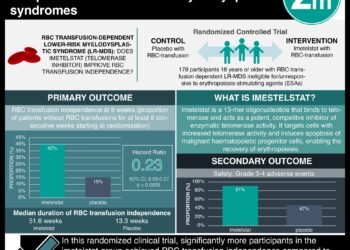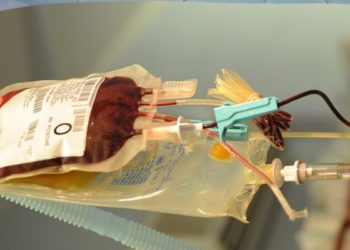Genetic mutation identified that underlies familial myelodysplastic syndrome [PreClinical]
1. Germline transmission of a mutation in ETV6 was identified in three distinct families presenting with myelodysplastic syndrome (thrombocytopenia and hematologic malignancy) inherited in autosomal dominant fashion.
2. In addition to myelodysplastic syndrome, patients with ETV6 mutations were also affected by a diverse set of malignancies including skin and colon cancer.
Evidence Rating Level: 2 (Good)
Study Rundown: Identifying clinical syndromes and risk from their genetic abnormalities has the potential to revolutionize (and personalize) clinical medicine. For example, BRCA1 and BRCA2 testing has helped clinicians stratify potential breast cancer patients into high and low risk groups as well as identify family members who are at risk. For most hematologic malignancies, very few germline mutations that drive transmission of syndromes have been identified. This is especially true for myelodysplastic syndrome (MDS), a broad diagnosis characterized by inefficient hematopoiesis with increased risk for development of acute leukemia.
In a recent study in Nature Genetics, researchers characterized three distinct families with mutations in ETV6. Each family had a unique missense mutation that led to slightly different clinical presentations (a missense mutation is the result of a single base pair change that leads to a single amino acid substitution). All three of the families presented with thrombocytopenia (sometimes initially misdiagnosed as immune-mediated thrombocytopenia), and one family also presented with anemia and neutropenia. In addition to the reductions in blood cell counts, many patients also developed malignancies. Interestingly, the hematologic malignancies were fairly broad and included multiple myeloma, chronic myelomonocytic leukemia, acute lymphoblastic leukemia, and mixed-phenotype acute leukemia. Patients with a mutant copy of ETV6 also commonly had skin and colon cancer.
Overall, this paper provides tremendous insight into a potentially important new genetic mutation underling MDS. Future work will need to be done to determine the frequency of these mutations as well as to develop diagnostic tests based on these insights.
Click to read the study in Nature Genetics
Relevant Reading: Clinical effect of point mutations in myelodysplastic syndromes
In-Depth: To understand the clinical spectrum of ETV6 mutations as well as the autosomal dominant inheritance pattern, the researchers performed a series of biochemical experiments. ETV6 encodes a transcription factor (a DNA binding protein) that regulates the expression of other genes. More specifically, the protein encoded by ETV6 acts as a repressor by binding DNA stretches and limiting their transcription. In this study, the researchers first sought to determine if the mutations they identified in the different families would limit the ability of the protein encoded by ETV6 to repress transcription.
The researchers introduced each mutant copy of ETV6 into a CD34+ stem cell line (CD34 is a bone marrow stem cell marker) to see how the mutant gene would affect bone marrow cell proliferation. Consistent with their clinical observations, they noted that expression of the mutant ETV6 significantly impaired stem cell proliferation (p < 0.01). They next sought to understand the mechanism of autosomal dominant transmission. Employing HeLa cells and luciferase reporters, the researchers observed dominant-negative ETV6 mutants inhibit the wild-type ETV6 repressive activity. This dominant-negative phenotype explained why patients who were heterozygous for ETV6 were still affected.
More from this author: Chronic marijuana use linked to structural differences in the brain, Flavanols in cocoa may improve brain function in older adults, Gut bacteria respond to daily rhythms and influence weight control
Image: PD
©2015 2 Minute Medicine, Inc. All rights reserved. No works may be reproduced without expressed written consent from 2 Minute Medicine, Inc. No article should be construed as medical advice and is not intended as such by the authors, editors, staff or by 2 Minute Medicine, Inc.








